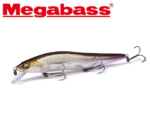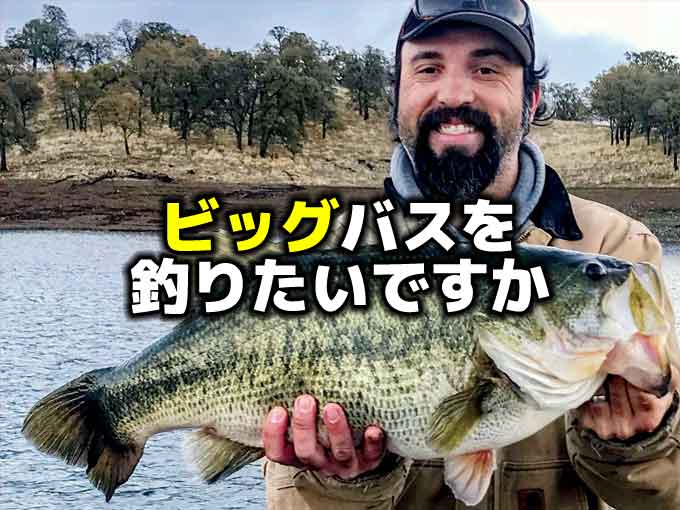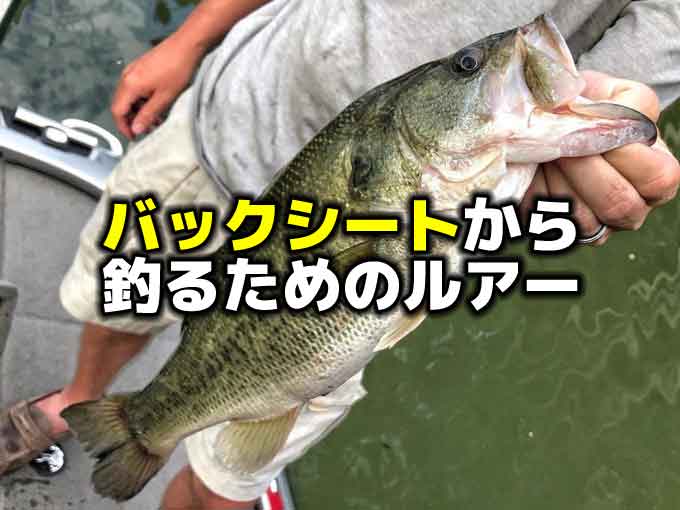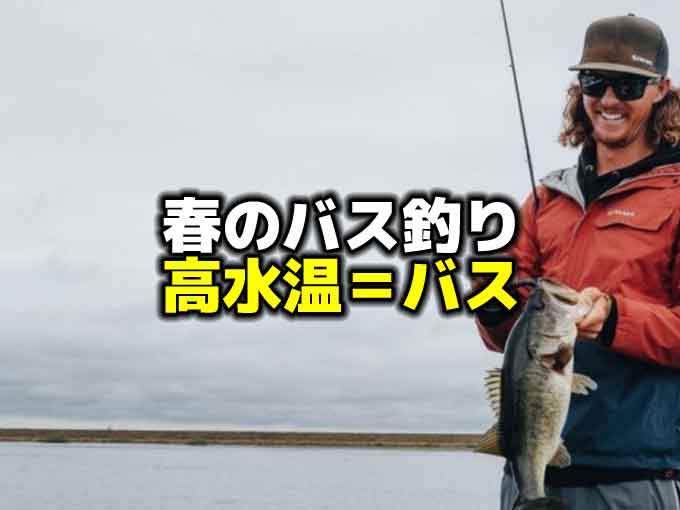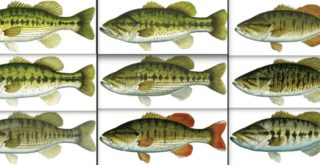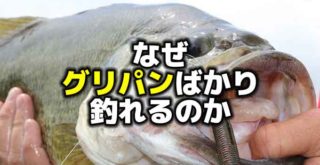ジャークベイトでのバス釣り

Photo by gameandfishmag.com
こんにちは!店長の小山です!
本日は海外サイトより、”Draw Bass Reaction With Well-Placed Jerkbaits”という記事を引用してご紹介いたします。
ジャークベイトの釣り。私がバス釣りをする中で一番好きな釣りで、唯一と言っていいくらい自信のあるジャンルがこのジャークベイトの釣りなんです。
ただ、勘違いしてもらっては困りますよ?ジャークベイトを使えば他の人より釣れるという意味ではないです。ジャークベイトは自分の中でも信じられるルアー、という意味で、自信のある釣りという意味ですからね(笑)、自分の中で、です。
もともとはシーバスでこの手のルアーを使うことが多かったのでタダ巻きメインで使っていたのですが、その使い方だとバスはあまり釣れないという印象でした。そのため、それほど好きではなかったのです。
それがある時、ジャークメインで使ってみると爆発したことがありました。八郎潟でルドラを使ったときです。バスもシーバスも同じポイントで釣れたのです。これは単に八郎潟効果だろうなどと思いつつも、何かつかんだような気がして、近所のフィールドでいろいろ試してみたところ、やっぱりよく釣れました。これは我ながらひとつ成長したなと思いつつも(笑)、ジャークベイトは「普通じゃない感じ」がしました。
釣れる魚がみんな怒っているのです。
ワームやジグの釣りはバイトがあったのを確認してからフッキングしてファイトが始まります。クランクベイトやスピナーベイトなども、巻きモノではありますがフッキングをしてからファイトが始まる感じですが、ジャークベイトはバイトもなにも即、全力ファイトが始まり、釣り上げたバスはヒレがすべて立ち、エラの開閉が激しく、見るからに怒っています。実際に怒っているかどうかは分かりませんが…。
それがなんだか嬉しくて、ジャークベイトの釣りが大好きになってしまいました。
この記事は、アメリカのフィッシングメディア「GAME & FISH」の記者、ジョン・フレッシャーが共有してくれたもので、ジャークベイトでのバス釣りについてプロの視点などから書かれたものです。
私の思い出なんかより数倍も、役に立つ具体的なことが書かれています(笑)
もしジャークベイトが苦手だなという方は、ぜひこれを読んでいただいて、ジャークベイトが好きになってくれたらいいなと思います。
早速読んでいきましょう。
ジャークベイトの誕生
In 1936, Lauri Rapala, a 31-year-old part-time lumberjack and full-time commercial fisherman in Finland, made two profound observations. While tending his lines, he noticed that big fish eat smaller fish and most fish wobble slightly when they swim, especially when injured. He also observed that predators would often dart into minnow schools and single out the ones struggling most to escape.
With that knowledge, Rapala carved, filed and sanded cork chunks into various shapes to create a wobbling lure that mimicked wounded baitfish. When Rapala finally came up with a design he liked, he wrapped his creation in tinfoil and coated the body with melted photographic negatives to seal it.
With a black back, gold sides and white belly, the long, slender lure resembled a minnow. After Lauri and his sons began catching more fish with the new lure, other fishermen begged Rapala to carve similar lures for them.
By 1959, the Rapala Original Floater hit the United States, but sales really skyrocketed three years later when an article in “Life” magazine proclaimed Rapala’s creation “A Lure Fish Can’t Pass Up.”
Growing up on the Gulf Coast, I often fished in tidal lagoons less than 3 feet deep. Grass matted the surface in many places, but stopped below it elsewhere.
Frequently, I caught more than 100 bass in a day, throwing only one lure: a three-treble-hook black and gold Rapala Original Floater, relatively unchanged for decades except switching from cork bodies to balsawood. Besides bass, I sometimes caught redfish, speckled trout and even an occasional flounder in those same marshes.
Back then, I didn’t even know to call it a “jerkbait,” a term that describes any long, slender minnow-like diving lure with a small lip that makes the bait dive under the water when an angler jerks the rod.
1936年、フィンランドの31歳のパートタイマーの木こりであり、フルタイムプロアングラーであるラウリ・ラパラ(ラパラの創業者)は、2つの深い観察をしました。彼はラインの手入れをしていると、大きな魚が小さな魚を食べるとき、ほとんどの小魚、特に怪我をしたものがわずかに揺れて(ウォブリングして)いることに気づきました。彼はまた、捕食者は小魚の群れに飛び込み、逃げるのに苦労しているものを選別していることに気づいたのです。
その知識によってラパラは、傷ついたベイトフィッシュを模倣したウォブリングするルアーを作り出すために、様々な形にコルクの塊を彫り、削り、磨きました。 ようやくラパラが納得できる形が出来上がると、それをアルミ箔で包んで、写真のネガを溶かして塗りました。
黒い背中、金色の脇腹、白い腹、長くてスレンダーなルアーはまるで小魚のようでした。ラウリや彼の息子たちがそのルアーで多くの魚を釣っているのを見て、他のアングラーたちも同じルアーを作ってもらうようラパラにお願いしました。
1959年にラパラ・オリジナルフローターは全米でヒットしましたが、その3年後に「LIFE誌」がラパラのルアーを「魚はこのルアーを無視できない」と記事にすると、売り上げはさらに急上昇しました。
メキシコ湾沿岸で育った私は、よく深さ1メートル未満の沼で釣っていました。多くの場所で水面にグラスマットがありましたが、場所によっては水面より下のところもありました。
かなりの頻度で1日に100匹以上は釣りました。しかも、1つのルアーでです。それは、コルクからバルサに変わったことを除いて、数十年に渡って変わることのない、3つのトレブルフックのついたキンクロのラパラ・オリジナルフローターです。バスのほかに、同じ沼地で時々レッドフィッシュやカワマス、ヒラメなども釣りました。
当時、私はそれを「ジャークベイト」と呼ぶことさえ知りませんでした。これは、アングラーがロッドでジャークしたときに少し潜るような小さなリップのついた、細長い小魚のようなダイビングルアーを意味する言葉です。
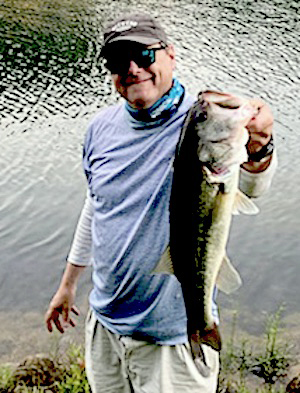
Photo by gameandfishmag.com
ジャークベイトの種類
Typically, I tossed these highly buoyant baits near a reedy shoreline or grassy patch and let it sit on the surface until the ripples faded. Then, I jerked the rod, causing the lure to dive a foot or two with an erratic side-to-side action. When it floated back to the surface, I let it sit for a few more seconds before jerking the rod again.
Sometimes, I’d pop the rod hard enough to make the lure gurgle the surface. I could also wake it just below the surface or run it 2 or 3 feet deep, keeping it just above the submerged vegetation. Sometimes, I’d reel the lure steadily for a while and then pause to let it float to the surface. Then, I’d jerk it down to the depth I wanted to fish and continue the retrieve for several more feet. As it wobbled through the water, the lure gave off significant vibrations. Habitually, bass followed it and hit the lure right at the boat with vengeance.
“I love to fish jerkbaits,” commented Randy Howell, former Bassmaster Classic champion. “They’re extremely versatile lures that can be fished in many different situations, particularly in water up to about 6 feet deep. I use them in the fall when the water starts to cool and fish start chasing baitfish, but they are effective all year long.”
Today, jerkbaits come in various configurations. Anglers can choose wooden or plastic models. Some float and some suspend or slowly sink, but the short lip always provides an erratic side-to side motion.
Floating jerkbaits usually dive about 1 to 3 feet deep. They work very well around shallow cover, such as weedy shorelines or submerged grasses growing to within a foot or two of the surface. They also work well around shallow, stumpy flats, flooded timber and similar cover near the surface. These baits fill a niche between topwater baits and deep-diving crankbaits.
“Although it has a lip, a floating jerkbait is actually a lot more like a topwater bait than a crankbait,” explained John Crews, professional bass angler. “A crankbait is more for fishing a steadier retrieve that makes contact with the bottom or hard cover. Jerkbaits are more for fishing higher in the water column so fish come up to eat them. Twitch them over bass beds.”
Slowly sinking or suspending jerkbaits look almost identical to floating models, but weigh a bit more. These baits often come with rattles for added enticement.
Some even enhance casting because metal pellets inside the bait move and transfer weight forward to make a bait sail much farther.
“Fishing a suspended jerkbait is totally different than fishing a floating jerkbait,” Howell advised. “A suspending jerkbait is a little heavier and people can throw it farther. When the angler stops the retrieve, it just hovers in the strike zone, giving fish a chance to eat it. When it’s moving, fish often trail it. When it stops in their face, they eat it reactively.”
Since these lures can cover long tracts of water, jerkbaits make excellent search baits.
For targeting schoolies, rip a suspending jerkbait through the baitfish school, making great flash and commotion. Then, pause so the bait hovers as if staring bass in the face and daring them to strike.
“Jerkbaits cause reaction strikes,” Crews said. “Programmed to eat the easiest prey, bass key on any injured or erratic baitfish. A jerkbait darting every which way gets bass fired up. It’s much easier for bass to catch and swallow a long skinny fish, which is what a jerkbait resembles, than a shorter, stubbier fish like a sunfish.”
Suspending jerkbaits can work in slightly deeper water than floating baits. Toss a suspending jerkbait to a good area and let it sink to the desired depth. Anglers can estimate the sink rate of a lure by counting down one second for each foot of depth.
Anglers can also make jerkbaits sink faster by giving the rod several vigorous jerks to make it dive deeper. At the desired depth, jerk it so it darts and dashes. Then pause. Bass often strike as the bait sits motionless.
“Jerkbaits are very good for targeting non-active fish and provoking a reaction strike in the middle of the day,” Howell explained. “To get really good with a jerkbait, fish it with a pop, pop, stop — pop, pop, stop cadence. Pause a couple seconds between the fall and the start back. Most often, bass hit on the pause. When the angler goes to jerk it again, the fish is on the line.”
For fishing suspending jerkbaits, use a 7-foot medium-light to medium rod with a soft tip. Use 12-pound test fluorocarbon line. Fluorocarbon sinks faster than monofilament and virtually disappears in the water.
一般的にこれら浮力の高いルアーは、葦の生えたショアラインまたはグラスパッチの近くに投げ入れ、水面に波紋がなくなるまで止め、ロッドをジャークしてルアーが不安定な左右の動きをしつつ30~60センチほど潜るようにします。そしてまた水面に浮いてきたら、数秒間待ってから再びロッドをジャークします。
時には、ルアーが水面をガーグリングするようにロッドを弾きます。また、ウィードのすぐ上を通すように水面下60~90センチを通るように巻いてウェイキングさせます。また時には、しばらくステディリトリーブで巻いてから、水面に浮いてくるまでポーズを入れ、またジャークで好みのレンジまで潜らせてから、残りの数メートルをリトリーブします。これにより水中でウォブリングし続けるため、かなりの波動を出します。本能的にバスはこれを追い、ボートの真下であっても襲ってきます。
「ジャークベイトの釣りは大好きです」と元Bassmaster Classicチャンピオンのランディ・ハウェルはコメントしています。 「特にそのフィールドの深さ約1.8メートルまでのさまざまな状況で釣れる、非常に汎用性の高いルアーです。私は水温が下がり始め、バスがベイトフィッシュを追い始める秋にそれらを使いますが、一年を通して有効です。」
今日では、ジャークベイトはさまざまなもので形成されています。アングラーはウッドまたはプラスチックを選択できます。フローティング、サスペンド、スローシンキングとありますが、いずれにしても短いリップは常に不規則な左右の動きを提供します。
フローティングジャークベイトは通常、約30〜90センチのレンジまで潜ります。これらはウィードのあるショアラインや水面下30~60センチに生える水中のウィードなどのシャローカバー周りでとてもうまく機能します。これらはまた、シャローのスタンプのあるフラット、沈んだ立木などのカバーの周りでもうまく機能します。このルアーは、トップウォータールアーとディープクランクベイトの間を埋めるルアーです。
「リップは付いているものの、実はフローティングジャークベイトはクランクベイトよりもトップウォータールアーに近いです。」とプロのバスアングラーであるジョン・クルーズは説明します。 「クランクベイトは、釣るためにはステディリトリーブで、ボトムやハードカバーにコンタクトして行きます。ジャークベイトは水中の高いレンジを釣ることの方が多く、魚を浮かせて食わせます。バスの居場所より上でジャークしてください。」
スローシンキングとサスペンドのジャークベイトはフローティングモデルとほとんど同じに見えますが、ウエイトが少し違います。追加の機能としてラトル入りのモデルもあります。
あるものは、キャスティングの飛距離を上げるためルアーの中を金属球が移動して重心移動させ、より遠くに飛ばせるものもあります。
「サスペンドジャークベイトの釣りはフローティングジャークベイトの釣りとはまったく違います。」とハウエル氏は指摘します。 「サスペンシドジャークベイトは少し重く、より遠くに投げることができます。アングラー側がリトリーブを止めると、ストライクゾーンにサスペンドし、魚に食べる機会を与えます。動いているときは魚はそれを追い、目の前で止まった時、バスはそれを反射的に食べるのです。」
このルアーは長い距離をカバーすることができるので、ジャークベイトは優れたサーチベイトにもなります。
スクーリングフィッシュを狙う場合は、サスペンドジャークベイトを群れの中に突っ込ませることで、派手なフラッシュとパニックを起こしてください。それからポーズを入れ、バスをじっと見て攻撃してこいと挑発するようにサスペンドさせてください。
「ジャークベイトはリアクションバイトを引き起こします。バスは最も簡単な獲物を食べるようにプログラムされていますから、傷ついて不安定なベイトフィッシュはキーになります。ジャークベイトがあらゆる方向に飛ぶことでバスにスイッチが入ります。バスが食べるとすれば、ジャークベイトのように細長い魚の方がブルーギルのように短くて太い魚よりもはるかに簡単なはずです。」
サスペンドジャークベイトは、フローティングより少し深いレンジを通すことができます。サスペンドジャークベイトをよさげなところに投げ、任意の深さまで沈めます。アングラーは、1秒ごとに30センチ潜るように巻くことで、ルアーがどこまで潜ったかを推定することができます。
アングラーは、ロッドを意識的にジャークさせることで、ジャークベイトをより深く沈めさせることもできます。希望の深さまで潜ったらジャークをして、ダートとダッシュをさせてください。その後ポーズを入れます。ルアーは動きのない状態で止まるので、多くはこの時にバイトします。
「ジャークベイトは、日中になって非アクティブになった魚をターゲットにして、リアクションバイトを引き起こすのに非常に適しています。 ジャークベイトでたくさん釣るには、ジャーク、ジャーク、ストップ。ジャーク、ジャーク、ストップ。のリズムで釣ってください。ポーズから動き出しの間は2、3秒止めます。ほとんどの場合、バスはポーズ中に来ます。アングラーがジャークを再開した時にフッキングします。」
サスペンドジャークベイトで釣りをするには、ソフトティップを持った7フィートのミディアムライト〜ミディアムのロッドを使用します。 12ポンドのフロロカーボンラインを使用してください。フロロカーボンはナイロンよりも速く沈み、水中で見えなくなるためです。
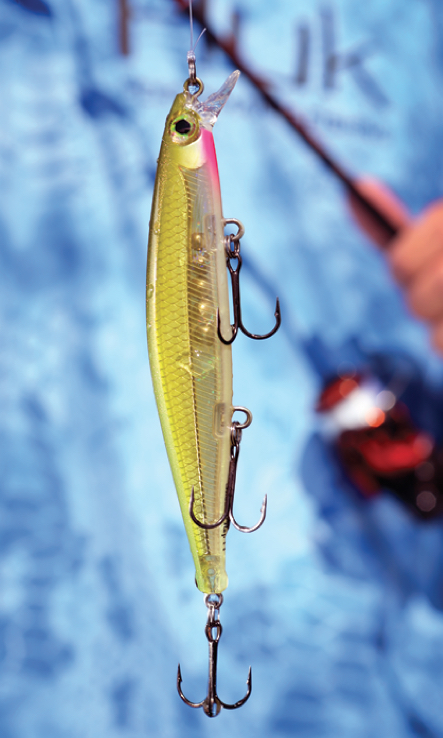
Photo by gameandfishmag.com
色々なバスにジャークベイト
Jerkbaits also work great for tempting smallmouth and spotted bass. When fishing for smallies, look for more rocky conditions and current. Smallmouth bass like chunk rocks and boulders with access to deeper water. Smallies also suspend more than largemouth and may run up from 25 feet deep to hit a jerkbait near the surface.
“I’ve had some good luck fishing for smallmouths with jerkbaits,” Crews remarked. “Smallmouth tend to stay more on vertical banks in creeks or the main river channels. I work a jerkbait the same for smallmouth as I do for largemouth, but I might add a bit of chartreuse into the color selection.”
Spotted bass frequently act more like smallmouths than largemouths and typically prefer cooler streams, deeper water and more current. Spots stay around main channel points, ledge edges with rock or woody debris, rocky shorelines, sandbars, riprap and similar places. Even in deep water, a hungry spotted bass might rise to attack a suspending or slow-sinking jerkbait worked vigorously above its head.
Both floaters and sinkers resemble baitfish and work best whenever bass feed upon shad or similar baitfish. Try to mimic what bass want to eat that day. When bass prey upon shad, use silver or silver and blue, gray, white with a black back or similar color combinations.
Simple to use, effective, jerkbaits remain on the market after decades because they continue to catch fish. While they might not catch fish in all situations, they frequently put fish in the boat quickly under the right conditions.
ジャークベイトは、スモールマウスバスやスポッテッドバスにも最適です。スモールを釣るときは、岩場や流れ(カレント)を探します。スモールマウスバスはディープよりのこぼれ岩や大岩が好きです。スモールはまた、ラージマウスに比べてサスペンドしがちで、水深7.5メートルから水面近くのジャークベイトを襲ってくることもあります。
「私がスモールマウスをジャークベイトで釣った時は、幸運に恵まれました。 スモールマウスは、クリークやメインリバーのチャンネルにある垂直の壁のようなところにいる傾向があります。私はスモールにもラージマウスと同じような使い方をしますが、カラーに少しチャートを加えるかもしれません。」
スポッテッドバスは、ラージマウスよりもスモールマウスによく似た行動をし、通常、低水温、ディープ、多くの流れを好みます。スポッテッドバスはメインチャンネルの岬周り、瓦礫や木くずなどの多い場所の岩や段差の角、岩場のショアライン、サンドバー、リップラップやそれに似たような場所についています。ディープであっても、空腹のスポッテッドバスは、頭上を元気に泳ぐサスペンドやスローシンキングのジャークベイトを攻撃しに浮いてくるかもしれません。
フローティングでもシンキングでもベイトフィッシュに似ており、バスがシャッドなどのベイトフィッシュを食べている時には最も効果的です。バスがその日に食べたそうなものを模倣してみてください。バスがシャッドを食べているときは、シルバー、シルバー&ブルー、グレー、ホワイト&ブラックバックやそれに似た色の組み合わせを使用します。
シンプルで、それでいて効果的なジャークベイトは、魚が釣れ続けているため、数十年間も市場に残っています。あらゆる状況で魚が釣れるわけではないかもしれませんが、適切な条件下では非常によく釣れるルアーです。
いかがでしたか。
適切な条件下ではよく釣れるなんていう表現がされていますが、やっぱり、そういうルアーなんですね。
ここに書かれている具体的なシチュエーションのほかに、私の好きな条件としましては「そのジャークベイトが潜るレンジにうまいことバスがいるとき」と考えております。
バスが水深1.5メートルにいると思ったら1.5メートル潜るジャークベイト、1.8メートルにいると思ったら1.8メートル潜るジャークベイトを使うんです。
なぜ1.5メートルとか1.8メートルにいると思うかと言えば、そこがウィードの上っ面だったりですとか、ベイトフィッシュが魚探によく映るなと思ったときでして、ただ、そんな細かいことを考えているようで実はかなり適当なチョイスでも大丈夫な気がします。結果的にやっぱりいたんだなと思うことの方が多いので(笑)
この記事にもあるように、ジャークベイトは寄せて食わせるルアーのひとつだと思いますので、ルアーやアクションのレンジ調節がアバウトでもバスの方から調節してくれるイメージです。
あとは根掛かりだけ気を付ければ大丈夫、みたいな感じです。
そこで私の大好きなルアーと言えばやはりメガバスのワンテンシリーズです。
現在のところ当店にはワンテンLBOしか在庫がございませんが、大変いいルアーですのでよろしければお試しいただければと思います。
それと、これも毎度毎度おすすめしておりますが、ラッキークラフトのビーフリーズ65SPです。これはスモールマウスももちろん効きますが、秋に小型ベイトフィッシュを食べているラージマウスにもすごく効きますので、よろしければこちらもお試しくださいませ。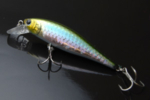
冒頭にも書いていますが、ジャークベイトで釣った魚は全部のヒレがカッと開き、写真映りも非常にいいです!そんなかっこいいバスをまた釣りたいものですね。
それでは、また。
毎度ありがとうございます!





